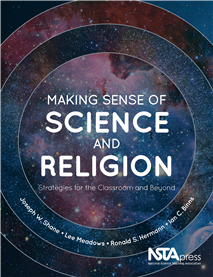NSTA Press
Making Sense of Science and Religion
By Carole Hayward
Posted on 2020-01-15
In the science classroom, the rigorous discussion of certain scientific concepts may challenge the religious beliefs of students as well as educators. Navigating these discussions in ways that respect diverse viewpoints, backgrounds, and experiences can be difficult, but a new NSTA resource can help.
Making Sense of Science and Religion: Strategies for the Classroom and Beyond by Joseph W. Shane, Lee Meadows, Ronald S. Hermann, and Ian C. Binns (NSTA Press), is designed for teachers at all grade levels. The book will help educators to anticipate and respond to students’ questions, as well as help students reconcile their religious beliefs even as the class delves into topics such as evolution, geochronology, genetics, the origin of the universe, and climate change.
Addressing science and religion is, the authors write, part of the educators’ collective job, and it is an inevitable part of teaching science in 21st-century America.
“Like many people, our students will sometimes come to us with religiously based understandings of the natural world and their roles in it. Other students may be antagonistic toward these perspectives. Others still will wonder what all the fuss is about and would just as soon stick to science. As usual, our job is to convey and model science in the midst of all of our students’ complex preconceptions, misconceptions, beliefs, values, joys, and social anxieties,” the authors state in the opening chapter.
Making Sense of Science and Religion explains the historical and cultural context of the intersections of science and religion in the classroom, plus it gives a framework for addressing science-religion issues in a legal, constitutional manner. It offers practical suggestions to help teachers develop lessons that align with the Next Generation Science Standards, and provides strategies for implementing effective questioning and designing assessments. For college faculty, Making Sense of Science and Religion gives an analysis of recent research findings and anecdotes related to navigating religion in the college science classroom.
To assist with carrying the discussion beyond the classroom, Making Sense of Science and Religion provides insight from professionals engaged in facilitating these types of complex and thoughtful dialogues with the general public in spaces that include churches, school board meetings, community events, or town halls, for example.
The authors themselves represent K–12 teachers, college professors, and experts from organizations such as the American Association for the Advancement of Science and the Smithsonian National Museum of Natural History, who bring a mix of different backgrounds and beliefs and share the goal of creating respectful, insightful educational experiences that will inspire students to grapple with challenging and important scientific topics.
Learn more about Making Sense of Science and Religion and check out the free chapter “Science and Religion in Middle School and High School Classrooms.”
Disclaimer: The views expressed in this blog post are those of the author(s) and do not necessarily reflect the official position of the National Science Teaching Association (NSTA).



